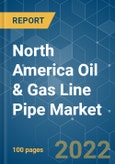The market for oil & gas line pipe in North America is expected to grow at a CAGR of over 2% during the forecast period of 2020 - 2025. Factors such as increased exploration activities and focus on the development of new oil and gas fields are expected to help drive the market for oil & gas line pipe. Moreover, increase in offshore activities, such as deepwater and ultra-deepwater production and development, are also driving the oil and gas pipeline market. However, the global shift towards renewable sources for electricity generation poses as a huge threat to the oil and gas demand, which is likely to be a major challenge for the growth of oil and gas line pipes installation in the coming years.
Key Highlights
- The seamless type segment is expected to witness significant demand during the forecast period, owing to the number of advantages when compared to other types.
- The rise in offshore exploration and production projects is expected to create an excellent opportunity for the market players in the years to come, as these projects are paving the way for line pipe industry to grow more.
- United States is expected to be the largest market during the forecast period, owing to the increased oil & gas exploration and production activities, that drives the demand for line pipe market in the coming years.
Key Market Trends
Seamless Type to Witness Significant Demand
- Seamless pipes are often made using round cross-section steel forms (called rounds) or square billets, which are rolled into a round shape. The seamless pipes are designed in a manner to bear high-stress conditions.
- These kinds of pipes are known for their ability to withstand pressure more efficiently in comparison to other methods of the pipe manufacturing process, as well as being fast and cost-effective. Seamless are generally used in gas lines, as well as pipes that carry liquids.
- They are also used in high-pressure applications like refineries, hydraulic cylinders, hydrocarbon industries, and in oil & gas infrastructures. In comparison to other types of piping, seamless pipes do not require any welding or joints and are simply formed by solid round billets, which adds on to its strength and other characteristics including corrosion resistance.
- In 2017, Tenaris produced its first seamless pipe at its Bay City, Texas, mill after having tested the complete hot rolling process. The production facility is Tenaris’ first greenfield project in 60 years. In May 2018, Tenaris has successfully started production at its seamless pipe mill about 80 miles southwest of Houston. The company invested a total of 1.8 billion dollars in the plant, located near the most active shale plays in the United States, to manufacture tempered OCTG goods for use in the production of natural gas and crude oil.
- In Jan 2020, Tenaris SA had completed its acquisition of IPSCO Tubular Inc, a US manufacturer of steel pipe, from PAO TMK. This acquisition implies that Tenaris is expected to be the exclusive distributor of TML’s OCTG and line pipe products in the United States and Canada.
- Therefore, based on the above-mentioned factors, seamless type segment is expected to witness significant demand during the forecast period.
United States to Dominate the Market
- The United States has dominated the oil & gas line pipe market, in 2019, and is expected to continue its dominance in the coming years as well.
- The country has seen a major rise in oil & gas production in recent years. From a global share in oil production at 9% in 2010, the country became the largest oil producer in the world in 2018, with a share of 16.1% of global oil production. In 2019 the share of the country’s oil production increased to an all-time high of 17.9%.
- In March 2017, the American Line Pipe Producers Association had announced its strong support for President Trump’s memorandum promoting the use of American-made pipe and steel in building pipelines across the United States. The Association has millions of tons of United States capacity available to ramp up production, which would add thousands of well-paying jobs in line pipe and supporting industries.
- In Feb 2019, the United States steel corporation is set to restart the No.1 Electric-Weld pipe mill at Lone Star tubular operations. The Lone Star No. 1 Mill is expected to provide full-body normalized electric-welded pipe in size ranges 7” to 16” outside diameter for customers across the United States, including the very active Permian Basin.
- Also, in April 2020, Liberty Steel Hartlepool has secured contracts to build more than 470 km of pipe for use in offshore and onshore energy infrastructure projects in the United States and Caspian Sea regions. The orders are for carbon steel linepipe, widely used to carry oil and gas. Fulfilling the orders - for 470 km (290 miles) of pipe - will involve producing linepipe of sufficient total length to run from Hartlepool all the way to London.
- Therefore, based on the above-mentioned factors, United States is expected to have a positive impact on the oil & gas line pipe market during the forecast period.
Competitive Landscape
The North America oil & gas line pipe market is fragmented. Some of the major players includes JFE Steel Corporation, Tenaris SA, Welspun Group, Vallourec S.A., and Jindal SAW Ltd.
Additional Benefits:
- The market estimate (ME) sheet in Excel format
- 3 months of analyst support
This product will be delivered within 2 business days.
Table of Contents
Methodology

LOADING...







![Steel Pipe Market: Trends, Opportunities and Competitive Analysis [2024-2030] - Product Image](http://www.researchandmarkets.com/product_images/12371/12371516_60px_jpg/steel_pipe_market.jpg)
